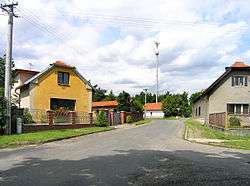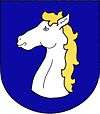Konárovice
Konárovice is a municipality (obec) in the Kolín District of the Czech Republic.
Konárovice | |
|---|---|
Municipality | |
 The village of Jelen, part of Konárovice | |
 Flag  Coat of arms | |
 Konárovice Location in the Czech Republic | |
| Coordinates: 50°2′30″N 15°16′30″E | |
| Country | Czech Republic |
| Region | Central Bohemian |
| District | Kolín |
| Area | |
| • Total | 10.89 km2 (4.20 sq mi) |
| Elevation | 225 m (738 ft) |
| Population (2011) | |
| • Total | 767 |
| • Density | 70/km2 (180/sq mi) |
| Time zone | UTC+1 (CET) |
| • Summer (DST) | UTC+2 (CEST) |
| Postal code | 281 25 |
| Website | www.konarovice.cz |
History
The first mention of Konárovice is from the time of the reign of Boleslaus II. of 976 – 999, who gave the surroundings of Kolín to his youngest son Oldřich. Prince Oldřich built a castle where the village of Přehráď now stands, and called it Oldřiš.
Konárovice was previously called Koňařovice. It is thought that in the 10th century there was a horseman living here, who belonged to the princely officials close to the castle and who bred the horses for the prince on the large meadows of Labe. The prince was not only a militant and power-greedy man, but also a great lover of hunting. He settled more servants in the vicinity – they kept sheep in Ovčáry, cattle in Bychory, hound dogs in Ohaře and birds of prey in Jestřábí Lhota, Kánín and Sokoleč.
The first written mention of the village is from the year 1352 in the registration of the Pope's tithes. In that time Konárovice had already been established as a knight's stronghold. The town's church was mentioned for the first time in 1358.
In the following centuries the owners of Konárovice often changed. In 1772 a farm was bought at auction by the Countess Elizabeth de Quasco. She used it as a summer residence and in 1775 rebuilt the chateau into its present form. Later in the year she ordered the building of a new parish house, but records of the first parish priest date only from 1820. Under control of the Countess, education flourished; in 1810 the 1st ordinary school was opened in Konárovice.
During this same period mulberry gardens were planted in Konárovice for the purpose of silk manufacturing. This trade became very successful, reaching its greatest flowering around 1820.
In 1856 Jan Nepomuk, Count of Harrach, engraving master and chamberlain, gained Konárovice and brought the local economy to its greatest prosperity. He then sold the entire estate to Josef Götzl, manufacturer and magistrate of Karlin. His family was often visited by violinist Jan Kocian, who held a small concert there.
Konárovice state bordered Bychory state, where the famous Czech violinist Jan Kubelík owned a castle.
The village includes a settlement, Jelen, where a brewery and a large restaurant were built in the 14th century. It also has a recreational settlement, Včelín, which has its own interesting history. Its name was derived from the beekeeping and the museum which was opened in 1928.
Winery
On the sunny slopes of Konárovice grapes have been cultivated since time immemorial. On one hill in Konárovice – Na Vinici - the last vineyard of the region was preserved until the beginning of the 20th century. Since 1995, the vineyards gradually have been renewed.
The soil is mainly clay, with loess and diluvian metal. Both land and location are suitable for cultivation of grapes, peaches and apricots.
The average annual temperature is 9.3 °C; the sum of annual precipitation is around 650 mm.
The climate is very similar to that of Southern Moravian (e.g. Velkopavlovická, 9.33 °C), suitable for the production of good wine. The most common current wine plantings are Moravian Muscat, Rhine Riesling, Pinot blanc and Aurelius.
Sightseeing
Near Konárovice there is a village called Žehušice, with the last white deer preserve in the world, and an Empire-era chateau called Kačina.
In the village of Konárovice there are several protected objects:
- the village chapel Na Labuti
- St. Jan Nepomuk statue
- the Virgin Mary statue
- the former hospital
A chateau (owned by American actor Crispin Glover[1]) and a church can also be found in Konárovice.
External links
- Official web site of Konarovice (in Czech)
- Tourist guide (in Czech)
- Konarovice Winery (in Czech)